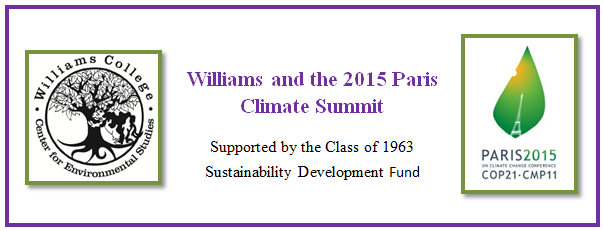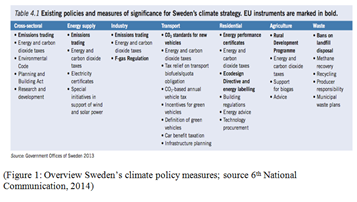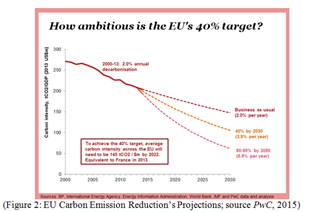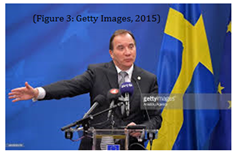By Christopher Wayland
Christopher is a senior Political Science and Economics major at Williams College with an interest in environmental politics. He is particularly interested in developing solutions to stopping transnational environmental crime.
When lobbying for increased government expenditure, universal healthcare, and other leftist policies, American liberals often highlight the successes of social democracies such as Sweden. In addition to its sound political institutions, Sweden’s progressive climate policies have also caught the attention of American liberal leaders. At a press conference in 2013, President Obama declared that Sweden’s progressive energy policies are the number one lesson the United States can learn from (Koronowski, 2013). By 2050, if Sweden continues to pursue ambitious domestic environmental policies, it could become the first carbon neutral nation.
Due to its strong domestic climate policies, Sweden has taken an environmental policy leadership position on the international stage. Therefore, although the European Commission and Latvia will represent Sweden at COP21 (although a Swedish delegation will be present), Sweden’s footprints are all over the negotiations. Sweden played an important role in the European Union INDC negotiations, its own commitments go beyond those of the European Commission, and it has provided financial support for the construction of INDC proposals in developing nations. Indeed, a deep dive into Swedish domestic and international environmental policies illustrates important themes at COP21 such as climate finance, sustainability, and multilateral negotiations.
Domestic Policy Leader
One of the key concepts and buzzwords at COP 21 is sustainable growth, or the ability to maintain positive GDP growth while also reducing carbon emissions. From 1990-2013 Swedish GDP grew by 58% while carbon emissions were reduced by 22% (Swedish Institute, 2015). Three key mechanisms have contributed to sustainable growth in Sweden: the creation of sustainable economic incentives, increased access to climate mitigation information for the public, and institutional collaboration between the public and private sector.
In the 50s and 60s the Swedish government made strategic investments in hydroelectric and nuclear power (Koronowski, 2013). Currently renewable energy accounts for 47% of all energy consumed in Sweden (Koronowski, 2013). While strategic investments have made renewable energy cheaper, a carbon tax has significantly increased the costs of fossil fuels. In 1991, Sweden began taxing carbon at $133 per ton and that figure has grown to $150, a cost that has received limited opposition due to the high price of imported oil (Koronowski, 2013). Only 27% of Sweden’s energy comes from fossil fuels, the lowest of any International Energy Agency country (Swedish Institute, 2015).
The Swedish public has historically been receptive to pro-environmental policies, in large part due to the Swedish government efforts to increase the amount of information accessible to the public. Each of the 290 municipalities in Sweden has an energy adviser who can provide information for individuals on topics such as low-energy household items (Swedish Institute, 2015). Additionally the government has invested in the development of numerous environmental think tanks and other governmental organizations that can keep the public informed of key environmental issues.
The Stockholm Environmental Institute, the Swedish EPA (oldest EPA in the world), the Vinnova (Government funded sustainable growth incubator), the Stockholm Resilience Center, and the Swedish Energy Agency play an important role in infusing scientific research into policies and ensuring that Swedish public and private sector continue to develop innovative environmental policies (Swedish Institute, 2015). Fostering an atmosphere of clean-energy innovation has allowed Sweden to become a pioneer in carbon neutral urban planning, biofuels, smart electric grids, electric cars, and carbon capture and storage (Swedish Institute, 2015). In addition to intergovernmental collaboration, the Swedish government works extensively with private sector businesses in developing clean energy technology. Funding and tax relief is available for businesses that make an effort to reduce energy use (Swedish Institute, 2015). For example, the government has partnered with Volvo to achieve its goal of achieving 100% electric cars by 2030 (Ministry of Energy and Environment, 2015).
With 4.5 billion SEK ($500 million) allocated in the 2016 budget towards climate initiatives, Sweden will continue to act as a domestic environmental policy pioneer (GOS, 2015b). As more and more countries look to generate sustainable growth and make binding commitments at COP 21, Sweden’s domestic policies should be disseminated and considered a template for replication. Sweden’s Sixth National Communication on Climate Change provides an in-depth analysis of these policies (Figure 1 provides an abbreviated description) (Sixth Communication, 2014).
Sweden’s COP21 and International Strategy
Sweden’s strong environmental policy domestic record has allowed it to play a proactive and ambitious role on the international stage. Last March, the Swedish Ministry of the Environment and Energy released an official strategy for a successful climate conference in Paris. The 8-page document, lists Sweden’s three targets for the conference, which include increasing global ambitions, developing a lasting climate change policy, and forging key alliances with developing nations. The document also discusses Sweden’s domestic, EU, and international policies for achieving these targets (MEE, 2015).
EU INDC Negotiations + Sweden’s Domestic Commitments
Since the EU nations submit a joint INDC to the UNFCCC, the negotiating process amongst EU nations is somewhat reflective of the negotiations that will take place at COP21. Indeed, progressive, developed Western European nations such as Sweden must bargain with lesser-developed Eastern European nations such as Poland whose economies are heavily reliant on coal and other fossil fuels.
In its COP21 strategy document, Sweden argues that for the EU INDC “an ambition level of 30 per cent reduction by 2020 and 50 per cent reduction by 2030 reflects the EU’s responsibility and capability” (MEE, 2015). True to this statement, during the negotiation process Sweden pushed for these targets however the EU settled on a 40% emission reduction rate by 2030 (King, 2014). Policy experts have correctly questioned the specifics and ambition of the EU INDC, in particular the vague references to land use, land use change, and forestry policy and the INDC’s failure to address surplus credits in the EU ETS (Evans, 2015). However, analysts from PwC have rebutted some of these claims, arguing that given the modest emission reductions rates since 2000 in the EU (2% per year, see figure 1), achieving the EU INDC targets will require “a step change in decarbonisation” (Grant and Milnes, 2015).
While not all countries in the EU have the capacity to produce this ‘step change,’ the EU is relying on countries such as Sweden that can go above the 40% target. In fact, Sweden’s own targets do exceed the EU targets: in 2009, the Riksdag (Swedish Parliament) approved two bills that established Reduced Climate Impact objectives including a 40% emissions reduction by 2020 from 1990 levels (excluding EU ETS emissions), a vehicle fleet independent of fossil fuels by 2030, and net-zero emissions by 2050 (Sixth Communication, 2014). Preliminary analysis shows that Sweden is on pace to achieve the first goal (Sixth Communication, 2014). Additionally, at the EU level, Sweden has continued to push for increased regional ambition: urging other states to cancel their Kyoto Protocol emissions surpluses, playing an active role in reforming the outdated EU emissions trading scheme, and pushing for the allocation of 20% of the EU’s budget to climate change activities (MEE, 2015).
In September the EU released a final position for COP21. Most of the policies outlined in the position, such as a commitment to using financial mechanisms to support poor countries and the adoption of an ambitious and durable legally binding agreement, are in line with the objectives laid out in Sweden’s strategy (Williams, 2015). Indeed, the Swedish government released a press statement saying that “the Swedish stance had a clear impact on the (EU) conclusions” (Williams, 2015). Thus, the EU INDC and positions for COP21 are reflective of Swedish interests.
However, due to the EU’s relatively smaller carbon footprint in comparison with the US and some of the emerging market economies and the growing pressures exerted by right-wing nationalists parties on climate budget policies in EU countries, experts argue that the EU’s influence at UN climate talks is diminishing (Evans, 2015). The Copenhagen conference was a particularly poor showing for the EU, highlighted by its absence from the final meeting when China and the US essentially formed a G-2 and struck a last-minute agreement. European nations though, including Sweden, have made a strong diplomatic push in order to increase the EU’s influence at COP21 (Nelsen, 2015). The push has emphasized both ‘soft power’ such as marketing campaigns and the formation of bilateral agreements with other nations and blocs (Nelsen, 2015).
International Environmental Policy – COP21
While EU climate conference policy is both reflective of and influenced by Swedish climate policy and interests, Sweden’s financial commitments and strategic partnerships played a key role in creating climate conference policy and enhancing institutional support for mitigation and adaptation in developing countries outside the EU. Internationally, Sweden has thus exhibited a commitment to a broad range of policy solutions such as multilateralism and climate finance.
Prior to COP21, the Swedish government invested SEK 12 million ($1.4 million) to three special projects that provided workshops, data analysis, and scientific support to African nations and Small Island Developing States in their efforts to craft INDCs and other climate related policies (GOS, 2015a). Sweden has contributed the most on a per capita basis to the UN Green Climate Growth Fund, a financial mechanism to assist developing countries in mitigating and adapting to climate change (GCF, 2014). Additionally, through the Climate Development Mechanism and Joint Implementation of the Kyoto Protocol, Sweden has actively sought to reduce GHG emissions and promote sustainable development in Least Developed Countries. Through the two programs, Sweden has contributed to seven multinational funds and signed contracts for 69 projects worth SEK 2.5 billion ($287 million) with an emphasis on African and Small Island Developing States (Sixth Communications, 2014). The emission reductions from these contracts, estimated at 40 Mt CO2 by 2020, compose one-third of the Riksdag’s 40% 2020 reduction target (Sixth Communications, 2014). At the domestic level, Sweden allocated an additional SEK 400 million ($45 million) to the Swedfund, which transfers clean-energy technology to the developing world (GOS, 2015d). Thus, through INDC support and capital transfers, Sweden will have a short-term and long-term impact on both climate conference policy and mitigation and adaptation efforts in developing countries.
Sweden is also very active in multilateral groups such as the New Climate Economy Project, Friends of Work Stream 2, and the Nordic Council, all of which seek to increase international ambition, bridge the gap between developing and developed countries, and facilitate the adoption of sustainable development goals (MEE, 2015). Additionally, Sweden has proven to be a useful bilateral negotiator, and has signed agreements with both smaller emitters such as Palestine and major emitters such as China and India (Swedish EPA, 2014). These agreements, which build Sweden’s spheres of influence and enhance its international bargaining power, are critical to attainment of Sweden’s objectives for COP21.
Even Sweden’s private sector corporations are enhancing Sweden’s international strategy. On November 25th, the Volvo group in partnership with the Stockholm Resilience Center held a conference to “gather leaders and stakeholders from government, the private sector and civil society in Stockholm to discuss how business can contribute to sustainable development” (Volvo Group, 2015). Highlights of the conference included a speech by Jan Eliasson, Deputy Secretary-General of the UN, and a productive Construction Climate Change roundtable discussion (CCC, 2015).
Conclusion
At COP21 the Swedish government will be represented by a delegation of seven ministers led by Minister for Climate and the Environment Asa Romson and Prime Minister Stefan Löfven (Figure 3). In preparation for the conference, Swedish government officials have maintained a strong international profile. In July, at the UN Finance for Development Summit, the Swedish delegation wrote an influential opinion paper addressing how Sweden plans to finance sustainable development (Williams, 2015). Then, At the UN Sustainable Development Goal meeting in New York in September, PM Löfven announced the formation of a ‘high-level group’ with eight other nations from around the world (Williams, 2015). The goal of the group is to ensure that the 17 global sustainable development goals and the 2030 agenda are not just adopted but also implemented. This trend of maintaining its strong international presence relative to its small size has continued at COP 21 where PM Löfven gave a press briefing outlining Sweden’s goals and interests on the opening morning, promised an extra SEK 250 million ($28.5 million) for LDCs, and highlighted fossil-free initiative (The Local, 2015).
As a climate policy pioneer, Sweden pursues ambitious domestic and international policies. As summarized by Prime Minister Stefan Löfven at a UN Sustainable Development Goal meeting, the Swedish government believes that these policies are not only in Sweden’s best interests, but also are ‘morally right’ (Williams, 2015). From EU policies, to international finance mechanisms, to developing countries’ INDCs, Sweden has already had a strong influence on the preparation for the conference. Hopefully, Sweden and the EU will also play an important in determining the outcomes of the conference.
Bibliography
Andalou Agency. 2015. “Stefan Löfven Conference.” Getty Images. Accessed Nov. 28. http://cache4.asset-cache.net/gc/463305176-swedish-prime-minister-stefan-lofven-speaks-gettyimages.jpg?v=1&c=IWSAsset&k=2&d=GkZZ8bf5zL1ZiijUmxa7QQmMFlN9%2FvZWgkfLHKmRx88BOfHCrcwm483xw4SX9Gp8XTP4dxpUjNWgyx2h9e55Rg%3D%3D
Cardon, Beatrice. Nov. 26, 2015. “Next Stop Paris.” Volvo Group. Accessed Nov. 28, https://europa.eu/eyd2015/en/volvo-group/stories/volvo-cop21
Construction Climate Challenge. Nov. 27, 2015. “CCC roundtable composes research recipe for the future.” CCC Workshop News Feed. Accessed Nov. 29, 2015. http://constructionclimatechallenge.com/2015/11/27/ccc-roundtable-composes-research-recipe-for-the-future/
Embassy of Sweden. Nov. 29, 2015. “Sweden’s goal: COP21 will result in an ambitious global climate agreement.” Government of Sweden. Accessed Nov. 29, 2015. http://www.swedenabroad.com/en-GB/Embassies/Amman/Current-affairs/News/Swedens-goal-COP21-will-result-in-an-ambitious-global-climate-agreement–sys/
Evans, Simon. March 3, 2015. “How ambitious is the EU’s offer to the Paris climate change talks?” Carbon Brief. Accessed Nov. 28, 2015. http://www.carbonbrief.org/how-ambitious-is-the-eus-offer-to-the-paris-climate-change-talks
Government Offices of Sweden. Aug. 17, 2015a. “Further Financial Support to Developing Countries ahead of the Climate Change Conference in Paris.” Government of Sweden. http://www.government.se/articles/2015/08/further-financial-support-to-developing-countries-ahead-of-the-climate-change-conference-in-paris/
Government Offices of Sweden. July 13, 2015b. “How Sweden wants to finance the world’s 17 sustainable development goals.” Government of Sweden. Accessed Nov. 28, 2015. http://www.government.se/opinion- pieces/2015/07/How_Sweden_wants_to_finance_the_worlds_new_development_goals/
Government Offices of Sweden. Oct. 21, 2015c. “Important Outcomes of a Meeting Between Sweden and South Africa.” Government of Sweden. Accessed Oct. 27, http://www.government.se/articles/2015/10/important-outcomes-of-meeting-between-south-africa-and-sweden/
Government Offices of Sweden. Sept. 28, 2015d. “Investments in Climate Change Adaptations and Energy.” Government of Sweden. Accessed Oct. 25, 2016. http://www.government.se/articles/2015/09/investments-in-climate-change-adaptation-and-energy/
Government Offices of Sweden. April, 10, 2015e. “Sweden and China Enter into agreement on climate change.” Government of Sweden. Accessed Oct. 25, 2015. http://www.government.se/press-releases/2015/04/sweden-and-china-enter-into-agreement-on-climate-cooperation/
Grant, Jonathan; Milnes, Rob. March 6, 2015. “How ambitious is the EU’s 40% target.” PwC. Accesed Nov. 28, 2015. http://pwc.blogs.com/sustainability/2015/03/how-ambitious-is-the-eus-40-target.html
Green Climate Fund News. Oct. 23, 2014. “Sweden Increases Levels for Climate Change Actions.” Accessed Oct. 25, 2015. http://news.gcfund.org/swedish-contribution/
Koronowski, Ryan. Sept. 4, 2013. “Why Obama Just Named Sweden as a Model for Energy Policy.” Think Progress.. Accessed Oct. 16, 2015. http://thinkprogress.org/climate/2013/09/04/2568981/obama-sweden-energy/
King, Ed. Oct. 17, 2014. “Sweden Calls on EU to agree 50% Carbon Cuts for 2030.” Climate Change News. Accessed Oct. 26, 2015. http://www.climatechangenews.com/2014/10/16/sweden-calls-on-eu-to-agree-50-carbon-cuts-for-2030/
International Energy Agency. 2013. “Energy Polices of IEA Countries: Sweden 2013 Review.” IEA. Accessed Oct. 30, 2015. http://www.iea.org/textbase/nppdf/free/2013/sweden2013_excerpt.pdf
Ministry of the Environment and Energy, Sweden. 2010. “Emissions in Sweden: History, Current Policy and the Future.” Government of Sweden. Accessed Oct. 25, http://ec.europa.eu/clima/events/docs/0045/sweden_en.pdf
Ministry of the Environment and Energy, Sweden. March 10, 2015. “Strategy for a Successful Climate Conference in Paris.” Government of Sweden. Accessed Oct. 24, 2015. http://www.government.se/contentassets/d9bbc2ed8b74418282c7fb0462b0f453/strategy-for-a-successful-climate-conference-in-paris-2015
Nelsen, Arthur. Jan. 20, 2014. “EU to launch diplomatic offensive ahead of Paris climate talks.” Euractiv in partnership with The Guardian. Accessed Nov. 27, 2015. http://www.euractiv.com/sections/climate-environment/eu-launch-diplomatic-offensive-ahead-paris-climate-talks-311418
Robert, Aline. Jan. 26, 2015. “Europe losing influence in climate negotiations.” Euractiv. Accessed Nov. 27, 2015. http://www.euractiv.com/sections/climate-change-road- paris/europe-losing-influence-climate-negotiations-311539
Sonja Van Renssen. March 5, 2014. “EU Deeply Divided over 2030 Climate and Energy Policy.” Energy Post. Accessed Oct. 25, 2015. http://www.energypost.eu/eu-divided-2030-climate-energy-policy/
Stefanini, Sara; Oraschokoff, Kalina. Nov. 28, 2015. “COP 21: Who’s who.”
Politico. Accessed Nov. 29, 2015. http://www.politico.eu/article/cop21-whos-who/
Swedish EPA. 2014. “International Cooperation at the Swedish Environmental Protection Agency.” Government of Sweden. Accessed Oct. 29, 2015. https://www.naturvardsverket.se/Documents/publikationer6400/978-91-620-8726-5.pdf?pid=14463
Swedish Institute. June, 2015. “Sweden Tackles Climate Change.” Accessed, Oct. 24, https://sweden.se/society/sweden-tackles-climate-change/
The Local. Nov. 30, 2015. “Sweden pledges more to fight climate change.” Accessed Nov. 30, 2015. http://www.thelocal.se/20151130/swedens-king-joins-global-leaders-at-climate-summit
Volvo Group. Sept. 15, 2015. “Next Stop Paris.” Accessed Oct. 25, 2015. http://news.volvogroup.com/2015/09/09/next-stop-paris/
Williams, Sean. September 2015. “Ahead of COP 21: Sweden’s Priorities.” Mundus International. Accessed Nov. 28, 2015. http://www.mundus-international.com/ahead-of-cop-21-swedens-priorities/




